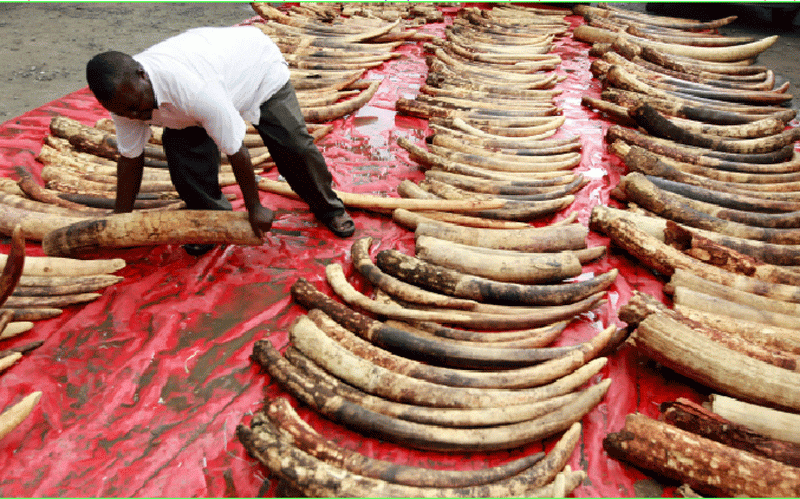
A UNITED States-based non-governmental organisation (NGO) welcomed a BBC report this month that Austrian scientists have developed a new artificial ivory product, called Digory, that looks and feels like the real thing.
The managing director of the United States-based Ivory Education Institute, Godfrey Harris thinks that when sufficient supplies of this artificial ivory is ready for market it could further reduce elephant poaching, allow governments to sell their stored elephant tusks, and encourage politicians to cancel their ban on trade in all worked natural ivory objects.
“Make this happen and it will generate much-needed funds for conservation as well as preserve high-end antique ivory artifacts now being lost to neglect,” Harris said.
“With the advent of this new artificial ivory, the desire for ivory jewellery, souvenirs, trinkets, seals and religious objects can be more easily satisfied.
“In addition, releasing real ivory back to artisans and bringing their original works to market will allow this fascinating material to reclaim its place in the world’s artistic pantheon.
“Cultured pearls — pearls started by sand particles inserted by man in farmed oysters — made these lustrous products of nature available to much larger numbers of people at much lower prices.”
The same can occur for this new artificial ivory — a chemically compounded material spun on a 3-D printer into the shape of an elephant’s tusk or a specific product design.
Harris said once much of the demand for the natural product is replaced by an artificial version, “poaching will lessen, but it won’t end”.
“Most of the BINGOs (Big International Non-Government Organisations), despite their protestations about a mission to save elephants from extinction, actually want the evils of poaching to continue,” notes Harris.
“Poaching gives the animal rights groups something to fight against.
“It lets them tell the public about the legislation they lobby for; engage in public information campaigns, such as ‘only elephants should wear ivory’; and justify the high salaries their executives command.”
Speaking on condition of anonymity for fear of withdrawal of funding by Western sources, a representative of an environmental NGO said that artificial ivory might whet appetites for genuine ivory as artificial ivory floods the markets.
He also noted that those who buy and show off what he called “fake” ivory would be ridiculed in the same way as people who buy fake Nike shoes or counterfeit Prada handbags.
“Moreover, those who support the sale of (artificial ivory) can be viewed as thieves who are engaged in a form of backdoor theft of Africa’s white gold (ivory) by suppressing its potential to generate income that can bring significant elephant conservation opportunities, while supporting socio-economic development, particularly in the elephant over-populated countries of Southern Africa,” he said.
When asked about this missed opportunity to sell genuine ivory to raise conservation funds, Harris exploded: “Typical of the BINGOs. Anything that threatens the US$600 million in annual donations they receive is to be opposed at all costs and with all guns blazing.
“They can’t have it both ways: On the one hand, opposing artificial ivory as a way to rob countries of their earnings from real ivory and then block those earnings by opposing the sale of real ivory as a threat to elephants.
“When was the last time the BINGOs favoured the sale of tusks for any purpose, let alone to meet conservation needs?”
In fact, over the years the fundraising industry of the animal rights NGOs have perfected the culture of lying about elephant poaching in Africa. They have even gone to the extent of conducting billionaire-funded elephant counts with the view to shocking the world that African elephant numbers are dropping drastically. This supports both their fundraising for “conservation” purposes as well as their efforts to close international markets for ivory sales.
Former CITES secretary-general and current president of the Switzerland-based IWMC-World Conservation Trust, Eugene Lapointe exposed the scandal behind the Great Elephant Census (GEC) conducted from 2013-2016.
The Great Elephant Census identified a 30% decline in savanna elephant population in just seven years. However, Mr Lapointe dismissed the 415, 000 final count as ‘media headline-line-grabbing’ and questionable. He noted that the IUCN claimed that was the total number of elephants in African elephant range states.
“(But the) IUCN admits that there are between 117 127 and 135 384 elephants in areas not systematically surveyed,” he wrote in his recently published book, Wildlife Betrayed.
“In addition, IUCN rarely tells the world that on top of this, there remains an additional 38% of (elephant) range for which no elephant population estimates are available.”
In 2016, the horrific results of this ‘badly flawed survey’ were then used to pressure the majority of 182 Cites-member-countries into voting for the immediate closure of the world’s biggest ivory markets to ‘save the African elephant that was facing a terminal decline’.
The following year, two of the world’s largest legal ivory markets (China and Hong Kong) bought the GEC dummy about the decline in African elephant population and closed their ivory markets. Japan did not fall for the GEC lie and has refused to shut down its ivory market.
Notably, only seven years after the phony Vulcan GEC report, the Southern African elephant range states are facing an elephant over-population problem. Yet the BINGOs continue to claim a decline in elephant population by expanding the parameters of their statistics or just referring to old suspicious facts.
Who cares, as long as the money pours in to ‘save elephants’.
Meanwhile, it remains to be seen, which African politician is going to be brave enough to take the lead in endorsing the League for Sustainable Conservation, a new and legal way to sell existing ivory stockpiles.
The drop in elephant poaching and illegal ivory trade through the sale of natural and artificial ivory would leave the BINGOs with nothing to lie about to get public support for their fundraising campaigns.
“The Ivory Education Institute is willing to give a prize for the most intricate, the most delicate and the most beautiful piece made on a 3-D printer from artificial ivory,” said Mr Harris, welcoming the sale of artificial ivory as a way to further reduce elephant poaching.
“We would like to plan on receiving photos of entries no later than November 2024 on our website, www.ivoryeducationinstitute.org. Watch for our announcements in the coming months.”
Meanwhile, Harris said he wonders when an artificial rhino horn might also be developed to reduce rhino poaching.
- Koro is a Johannesburg-based environmental journalist, who writes independently on environmental and developmental issues in Africa.






